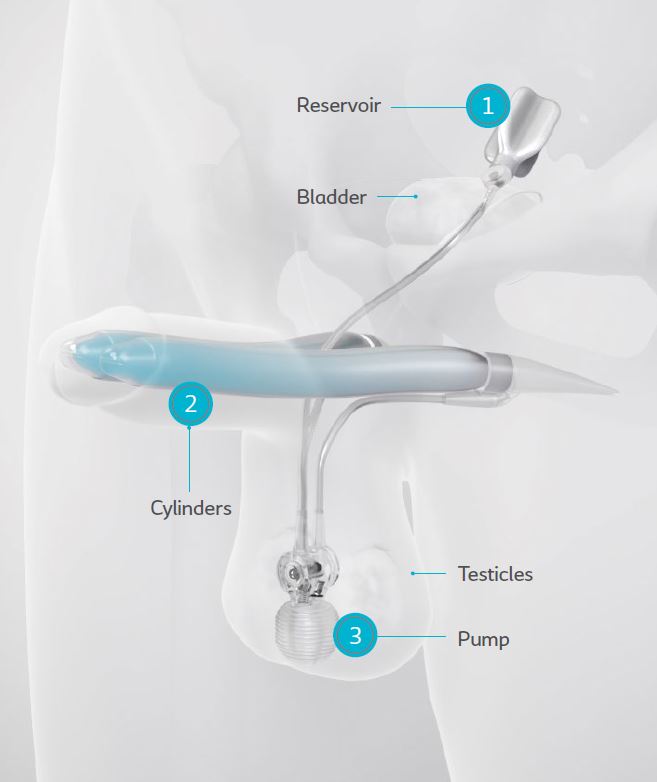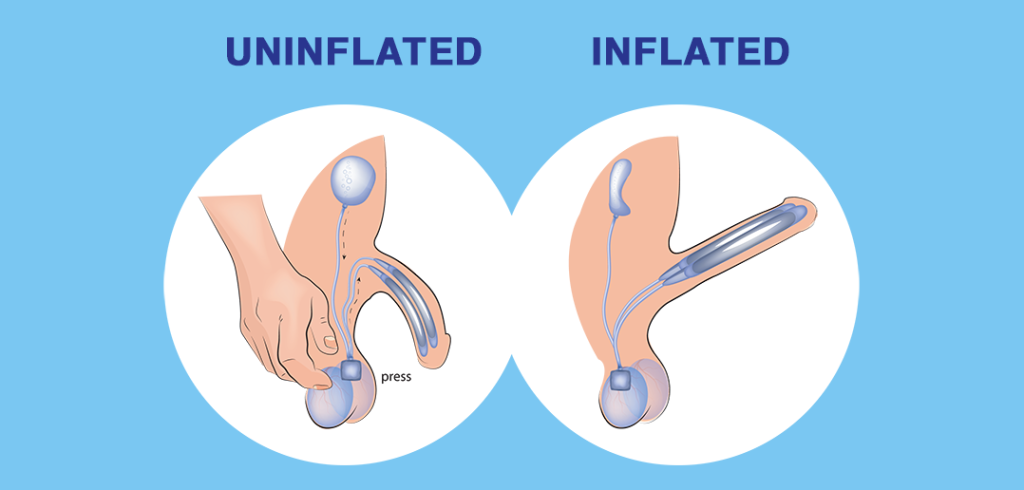What is a penile implant?
A device known as a penile implant has been created to assist men in achieving erections, which remains concealed within the body. This device empowers men to take control of their body, enabling them to obtain an erection practically anytime. Unlike other remedies for erectile dysfunction (ED), the penile implant reinstates spontaneity and enables men to acquire an erection without any forethought or delay.

The gadget is inserted through a minor incision in the skin using a surgical process. After the operation, most men go back to their homes on the same day and can resume their sexual activity as permitted by their physician, usually after 4-6 weeks.
Why should I get a penile implant?
Although pills are frequently prescribed as the primary treatment for erectile dysfunction, they are not always a permanent solution. Pills are used to treat 75% of patients with ED initially, but half of them will stop taking them within a year due to issues like insufficient effectiveness, high prices, or apprehensions about potential adverse effects or long-term safety. In such situations, some individuals will switch to a different medication brand, some will experiment with penile injections, and some will opt for a penile implant.
Patients who have already attempted alternate treatment methods such as oral medications and penile injections will proceed to second line treatments.
There are patients who switch to a penile implant when pills and injections fail to work, while others opt for it initially. Use of penile implants has been proven as a more economical solution for treating ED in the long run.
What is a penile implant?
A surgical device that is implanted into the penis is called a penile implant, and it serves the purpose of assisting in achieving an erection, particularly for those who suffer from erectile dysfunction (ED).
There are two types of penile implants:
- An implantable device that can be inflated is placed in the penis, with a pump placed inside the scrotum to enable the person to attain an erection on demand.
- A non-inflatable penile implant involves the use of flexible silicone rods placed inside the penis’ erection chambers, which can be extended to achieve an erect position.
The terms penis implant and penile prosthesis are alternative names for a penile implant.
What kind of person would be a suitable choice for a penile implant?
Many individuals who are suitable for a penis implant are affected by ED or Peyronie’s disease. Nevertheless, their situation cannot be naturally improved or treated conservatively through various medical methods, such as drugs or a penis pump.
As part of gender affirmation surgery, healthcare professionals may suggest the use of penile implants which are inserted following a metoidioplasty or phalloplasty operation to create a penis.
Surgical Treatment

The primary surgical approach for addressing ED is the introduction of a penile implant, which is alternatively referred to as a penile prosthesis. Elderly males who have not benefited from oral PDE5 inhibitors, ICI, or IU therapies are not recommended to undergo penile vascular surgery. Therefore, a penile implant is the next logical option for these patients. Despite the fact that penile implant placement is a surgical operation that carries inherent risks, it is also the most prosperous and fulfilling alternative among treatments for ED.
Penile implants are internal devices that can help achieve a rigid penis for regular sexual activity. It is a great option to enhance sustained intimacy and promote more unplanned experiences.
There are two types of penile implants.
Semi rigid Implant (Bendable)
The most basic type of implant consists of a pair of flexible bars, typically crafted from silicone, which provides the necessary rigidity for sexual intercourse. These rods can be contorted downwards for urination or upwards for sexual activity.
Inflatable Implant
An inflatable implant involves the insertion of fluid-filled cylinders into the shaft of the penis. These cylinders are connected to a pump situated inside the scrotum such that when activated, the cylinders fill with pressure, causing the penis to become stiff and erect. Inflatable implants are designed to create a normal-looking erection that feels natural to a partner. To facilitate this, a surgeon may recommend the use of lubricants. With the implant, men have the ability to adjust the level of firmness and, in some cases, the size of their erection. The presence of an implant also allows couples to be intimate on a whim. Usually, there are no adverse effects on a man’s sensation or ability to orgasm.
What is the Surgery Like?
Anesthesia is commonly used during penile implant surgery. If a patient is currently experiencing infections in their urinary tract, skin or body as a whole, it is advisable to wait until the infections are treated before undergoing surgery. Men who are taking blood-thinning medications may need to consult with a medical professional before stopping their medication in preparation for surgery and during the recovery process.
Usually, a minor surgical incision is created either above the point where the penis meets the abdomen or underneath where the penis connects to the scrotum. No tissue is extracted, and blood loss is minimal. The patient may be discharged on the same day or may need to stay overnight in the hospital.
Recovery Time after Penile Implants:
- The majority of males may experience discomfort and find relief with a potent painkiller for a duration of one to two weeks. Once the initial week has passed, non-prescription pain medications like acetaminophen or ibuprofen could be used instead of the narcotic painkillers.
- The discomfort, bruising, and swelling following the surgery will persist for several weeks.
- During the initial 30 days, it is advisable for males to reduce their level of physical exertion. The surgeon will provide guidance on the appropriate timing and extent of exercise to engage in while recuperating from the procedure.
- In most cases, men begin engaging in sexual activity with their penile implants approximately two months after undergoing surgery. However, if swelling or discomfort persists, the use of the implant may be postponed. The surgeon or medical professional at the surgeon’s office will provide instructions on how to inflate and deflate the implant.
Before undergoing prosthetic surgery, patients are advised of the potential hazards involved. In the event that there is an infection after the surgery, it is probable that the implant will have to be taken out. While these gadgets are dependable, if they break down mechanically, one or more components will have to be surgically replaced. If a penile prosthesis is removed, other forms of treatment not requiring surgery may no longer be effective.

The majority of men who have undergone penile implant surgery and their significant others express contentment with the outcomes and find themselves engaging in more natural sexual activity.
After Treatment
With the exception of implant surgery, all of the remedies for ED are utilized on demand during sexual activity, and their effects eventually diminish. These remedies aid in alleviating the symptoms, but they don’t resolve the root issue in the penis.
If medical interventions are not as effective as anticipated:
- Making adjustments to the prescribed dosage of PDE5 inhibitors, intracavernous injections (IU), or intracavernosal injections (ICI) alprostadil may be beneficial under the guidance of a physician.
- If you review the instructions once more, you might discover that a certain step is missing in the treatment plan.
- It may be useful to explore alternative options such as counseling for emotional or relationship support, using a vacuum erection device or getting a penile implant if traditional methods are not effective. It is important to persist and not lose hope.
How long does a penile implant last?
In general, penile enhancements have a lifespan of about two decades. Once the device loses its functionality, it becomes ineffective. Your medical specialist may perform a revision surgery by taking out the old implant and inserting a new one.
What benefits does a penile implant offer?
The primary benefit of having a penile implant is that it enables you to achieve a sturdy enough erection for sexual activity at any time and for as long as you desire. It does not affect the feeling on the surface of your penis or your capacity to have orgasms and release semen.
There are further benefits to having a penile implant, such as:
- The process is quite secure, and there is a less chance of any unwanted outcomes or adverse impacts.
- The outcomes are fulfilling. More than 90% of individuals who have undergone a penile implant procedure express satisfaction with the results.
- Penile enhancements have a sturdy construction. Fresh installations can endure up to two decades.
- The process can be completed without requiring an overnight stay at the hospital. Typically, it takes from one to two hours to perform, and the majority of patients are able to return home on the day of the procedure.
- Increased self-esteem.
How long does it take to recover after having a penile implant?
It is essential to bear in mind that each individual’s body is distinctive, and therefore, the healing period will differ. Typically, after one week, pain, swelling, and discomfort should reduce. However, you may experience soreness for as long as six weeks.
Treatment in Türkiye:
The medical staff of surgical teams, doctors and consultants in Rehab Türk can provide the best treatment options and free consultations – by striving to keep abreast of the latest medical technologies and methods.

